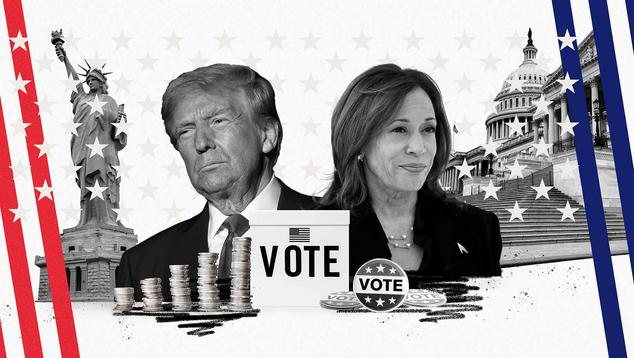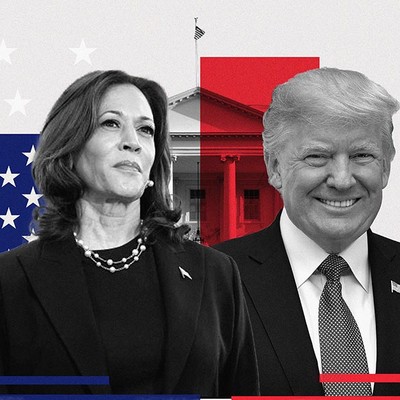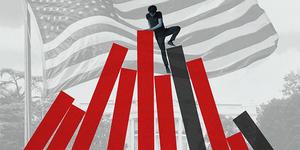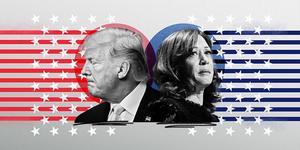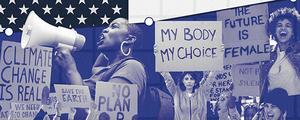Story Highlights
- Americans’ views of the economy and nation’s direction still negative in October
- Harris and Walz earn higher favorable ratings than GOP counterparts
- Democratic and Republican parties evenly matched in favorability
WASHINGTON, D.C. -- Gallup metrics tracking the nation’s mood continue to show Americans feeling negatively in October about the economy, the direction of the country and President Joe Biden’s job performance -- indicators that work in Republicans’ favor this election. At the same time, Americans rate the Republican and Democratic parties similarly, while viewing Kamala Harris more favorably than Donald Trump.
These findings are from Gallup’s October polling on several key dimensions about the state of the nation and presidential campaign. Gallup previously reported on the electoral significance of several of these metrics as measured in September, and, given the relative stability of the results this month, that analysis still holds.
This article examines the latest results by party, showing strong differences between Republicans and Democrats in the expected directions. That leaves the views of political independents as potentially most important to the presidential election outcome on Nov. 5 as Americans cast their ballots.
Economic Confidence
With the economy ranking as the top issue Americans say they will consider when voting, it’s notable that public confidence in the economy still skews strongly negative.
As Gallup has seen since inflation began rising in 2021, more Americans continue to describe national economic conditions as “poor” (46%) than as “excellent” or “good” (25%). Likewise, a much larger proportion say the economy is “getting worse” (62%) rather than “getting better” (32%). The average of these net perceptions results in a -26 score on Gallup’s Economic Confidence Index for October. This is based on Gallup’s Oct. 1-12 poll and is more in line with elections the incumbent party lost (in 1992 and 2020) than won.
Republicans and Democrats hold opposing views about the economy -- with large majorities of Republicans rating it “poor” and perceiving it is getting worse, while the slight majority of Democrats call it excellent or good, and two-thirds think it is getting better.
Independents’ views of the economy fall closer to those of Republicans than Democrats, with the slight majority rating the economy poor and about two-thirds saying it is worsening. This results in a -34 Economic Confidence Index score for independents, slightly worse than the national average.
Direction of the Country
Twenty-six percent of Americans in Gallup’s final preelection poll, conducted Oct. 14-27, say they are satisfied with the direction of the country, whereas 72% are dissatisfied.
Satisfaction is up slightly from 22% earlier this month, mainly because it has increased among independents, rising seven points to 25%. Meanwhile, Republicans’ satisfaction is down slightly from the 9% recorded Oct. 1-12, while Democrats’ hasn’t changed.
To date, the incumbent party has not won a presidential election with satisfaction this low, including in 1992 (22%), 2008 (13%) and 2020 (28%). The lowest satisfaction rating in a year the incumbent party won was 33% in 2012.
Incumbent Job Approval
President Joe Biden’s job approval rating stands at 41% in late October, consistent with his rating over the past three years, including the time since his withdrawal from the presidential race in July. His Oct. 14-27 rating is dampened by 77% of Democrats approving -- subpar for a president’s party -- along with 38% of independents and just 6% of Republicans.
By contrast, Harris’ October job approval rating (measured in the early October survey) is slightly higher, at 45%, reflecting 94% of Democrats, 41% of independents and 8% of Republicans rating her positively.
As Gallup has previously noted, it is difficult to know how significant a sub-50% job approval is for a sitting vice president running for president, because there are not enough recent examples of this. Whereas incumbent presidents seeking reelection with less than a 48% approval rating have all lost, it’s unclear whether vice-presidential nominees’ prospects are as tethered to their vice-presidential rating.
Candidate and Party Favorable Ratings
Gallup’s final preelection reading of how Americans view the presidential and vice-presidential candidates asks simply whether respondents have a favorable or unfavorable view of each.
Overall, 49% of Americans have a favorable view of Kamala Harris, slightly higher than the 44% viewing Trump favorably.
Harris’ running mate, Tim Walz, earns a higher favorable rating than Trump’s vice-presidential pick, JD Vance -- 45% versus 39%, respectively. Walz alone among the four candidates has a significantly higher favorable than unfavorable rating, whereas both Trump and Vance are viewed more unfavorably than favorably.
Despite Democrats’ advantages in favorability nationally, they are close to parity with Republicans among political independents. In this critical swing group, Harris is viewed favorably by 44% and Trump by 42%, while Walz edges out Vance, 39% to 36%.
Harris’ higher favorable rating than Trump’s nationally with this measure is notable, given that the candidate with the higher favorable rating has typically won recent presidential elections. Trump defied this pattern in 2016 when trailing Hillary Clinton in favorability, 35% to 40%, but did so by winning in the Electoral College, while Clinton won the popular vote. Using a different measure of favorability earlier this month, Gallup found Trump and Harris nearly tied, with 50% of Americans giving Trump a positive rating from +1 to +5 and 48% doing the same for Harris.
Meanwhile, Americans have similar views of the two major political parties in the latest poll: 44% have a favorable view of the Republican Party, and 43% have a favorable view of the Democratic Party. This masks a significant edge for the Republican Party with independents, among whom 42% view the Republican Party favorably and 33% the Democratic Party. The Republican advantage is somewhat offset by fewer Republicans than Democrats viewing their respective parties favorably -- 87% for the Republicans versus 92% for the Democrats.
Bottom Line
Americans’ broad pessimism about the country’s direction, combined with dour assessments of the nation’s economy and Biden’s job performance, create a difficult environment for Harris in seeking to keep Democrats in charge at the White House.
In spite of these handicaps, Harris and her running mate have emerged from three months of campaigning earning higher favorable ratings nationally than their opponents. On the other hand, she does not appear to enjoy the same advantage among political independents, who could prove to be the swing vote in this election.
Taken together, this mix of findings offers encouragement for both campaigns -- for Trump, that people may be looking for change, and for Harris, that she is the more appealing candidate. Both findings are consistent with themes seen in recent polling, including Trump leading Harris as better able to handle the economy, while Harris is seen as having higher moral character.
Meanwhile, the tie in favorability between the Republican and Democratic parties could portend a close race in the other national election -- votes for U.S. House candidates that will decide control of Congress.
To stay up to date with the latest Gallup News insights and updates, follow us on X @Gallup.
Learn more about how the Gallup Poll Social Series works.
View complete question responses and trends (PDF download).
